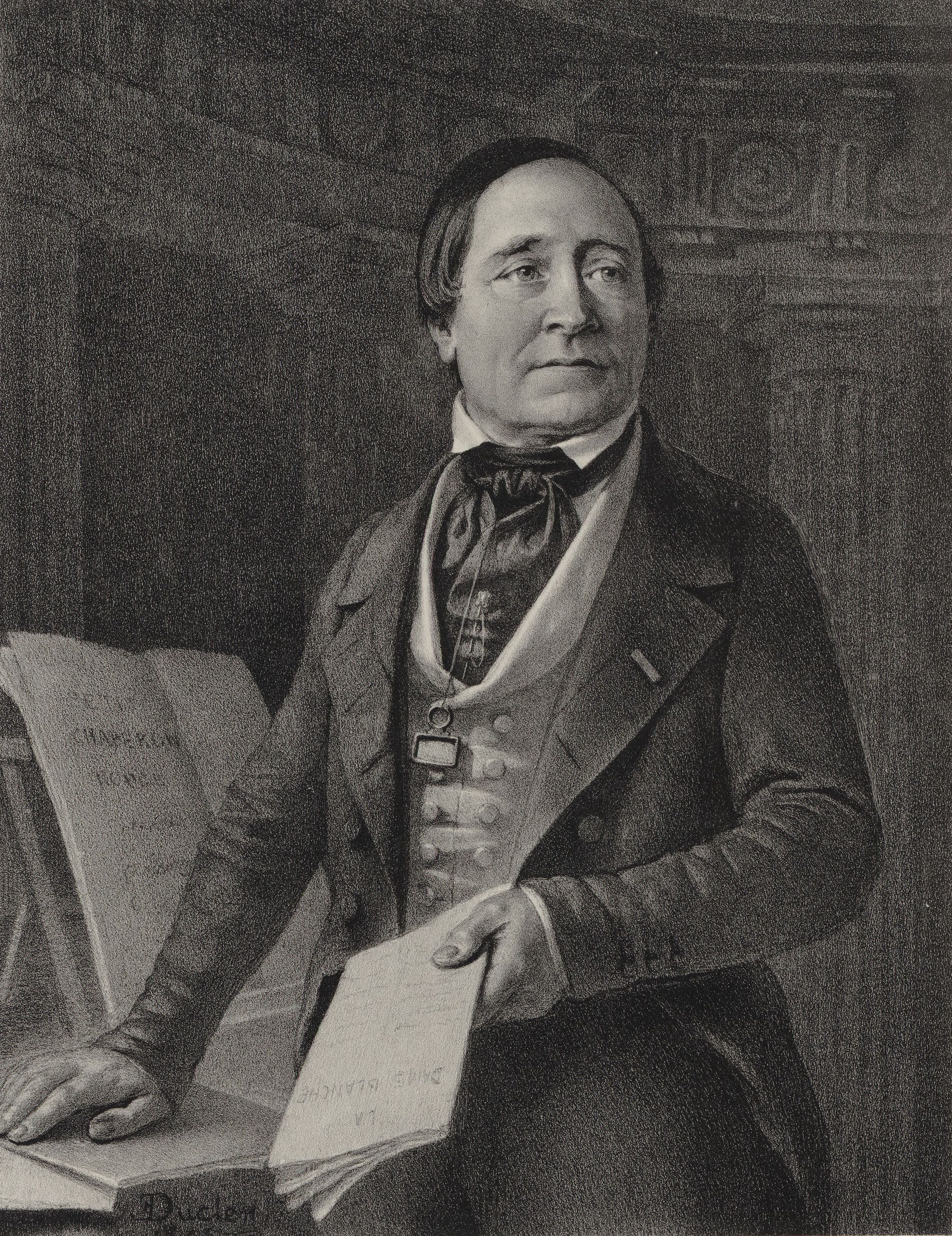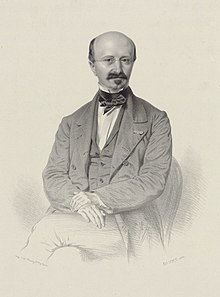
The Conservatoire de Paris, also known as the Paris Conservatory, is a college of music and dance founded in 1795. Officially known as the Conservatoire National Supérieur de Musique et de Danse de Paris (CNSMDP), it is situated in the avenue Jean Jaurès in the 19th arrondissement of Paris, France. The Conservatoire offers instruction in music and dance, drawing on the traditions of the 'French School'.

Alexandre-Étienne Choron was a French musicologist. For a short time he directed the Paris Opera. He made a distinction between sacred and secular music and was one of the originators of French interest in musicology.

Charles Edmond Henri de Coussemaker was a French musicologist and ethnologist focusing mainly on the cultural heritage of French Flanders. With Michiel de Swaen and Maria Petyt, he was one of the most eminent defenders of the Dutch language in France.

Pierre-Louis-Philippe Dietsch was a French composer and conductor, perhaps best remembered for the much anthologized Ave Maria 'by' Jacques Arcadelt, which he loosely arranged from that composer's three part madrigal Nous voyons que les hommes.

Robert Bruce is an 1846 pastiche opera in three acts, with music by Gioachino Rossini and Louis Niedermeyer to a French-language libretto by Alphonse Royer and Gustave Vaëz. The plot concerns the defeat of the forces of Edward II of England by Robert the Bruce, King of Scots, and is adapted from Walter Scott's History of Scotland. The music was stitched together by Niedermeyer, with the composer's permission, with pieces from La donna del lago, Zelmira, and other Rossini operas. The work was premiered on 30 December 1846, by the Paris Opera at the Salle Le Peletier. The audience may not have noticed, but the orchestra included for the first time a recently invented instrument, which later came to be known as the saxophone.

Rosine Stoltz was a French mezzo-soprano. A prominent member of the Paris Opéra, she created many leading roles there including Ascanio in Berlioz's Benvenuto Cellini, Marguerite in Auber's Le lac des fées, the title role in Marie Stuart, and two Donizetti heroines, Léonor in La favorite and Zayda in Dom Sébastien.

Marie Stuart is a grand opera in five acts composed by Louis Niedermeyer to a libretto by Théodor Anne loosely based on events in the life of Mary, Queen of Scots. It premiered at the Théâtre de l'Académie Royale de Musique in Paris on 6 December 1844 with Rosine Stoltz in the title role.

Alexandre Édouard Goria was a French virtuoso pianist and composer recognised among amateurs enthusiasts for his numerous salon pieces of different styles, which enjoyed great success at their time. The number of fancy arrangements and transcriptions by Goria of selected motifs from great operas proves the composer's great facility and the popularity of his name, which had commercial value. He was a favorite artist of lovers of brilliant music, concert and salon music.

Paul-Louis Rougnon was a French composer, pianist and music educator.

The École Niedermeyer is a Paris school for church music. It was founded in 1853 by Louis Niedermeyer as successor to the Institution royale de musique classique et religieuse, which had been established and run by Alexandre-Étienne Choron between 1817 and 1834. Several eminent French musicians studied at the school, including Gabriel Fauré, André Messager and Henri Büsser.

Louis Antoine Ponchard was a 19th-century French operatic tenor and teacher.
Gustavo Carulli, called Gustave Carulli in French publications, was a composer, musician and music teacher.

Joseph Louis d'Ortigue was a French musicologist and critic. A specialist in liturgical music and a conservative Catholic of ultramontane and royalist leanings, he was a close friend of both Berlioz and Liszt. His most influential work was Dictionnaire liturgique, historique, et theorique de plain-chant et le musique d'église, but he also wrote for many of the most prominent periodicals of the day, including Journal des débats and Le Ménestrel where he was the editor-in-chief from 1863 until his sudden death at the age of 64.

Antoine Aimable Elie Elwart was a French composer and musicologist.

Victor Frédéric Verrimst was a French double-bassist and composer.

Louis-Barthélémy Pradher was a French composer, pianist and music educator.
Eugène Wintzweiller was a French composer, winner of the second Grand Prix de Rome in 1868.
Joseph Wackenthaler was a French Kapellmeister from 1819, an organist from 1833 to 1869 at the Cathédrale Notre-Dame de Strasbourg, and a composer.

Louis-Augustin Richer was a French singer, singing professor and composer. He was a member of a family of musicians from Versailles who also had close ties to the family of André Danican Philidor. He gained prominence as a singer at the courts of Louis XV and Louis XVI and also served as Maître de musique for the courts of the Duke of Chartres and the Duke of Bourbon. After the abolition of the monarchy during the French Revolution, Richer became a professor at the Paris Conservatory.

Charles-Henri Plantade was a French classical composer and singing professor. His compositions included several operas, numerous romances, sacred music, and a sonata for harp. He taught singing at the Conservatoire de Paris and was the maître de chapelle to the courts of Louis Bonaparte in Holland and Louis XVIII in France. From 1812 to 1815 he was also the singing master and stage director of the Paris Opéra. Plantade was born in Pontoise and died in Paris at the age of 75. His elder son, Charles-François Plantade, was also a composer.


















